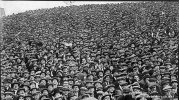Smudger
master brummie
I had no idea of what a slide rule was. Never heard of one till this topic came up on bhf. At school we only had a slate & a nail to scribble answers, then after a while someone invented chalk. Seriously though, i remember logarithms classes simply because that particular teacher was easily distracted by asking him about his time with the Gurkhas or learning Christmas song in German.I disliked maths but loved to look at and ‘play’ with my dad’s slide rule. He showed me how to use it but I doubt I’d remember the first thing about them now.
Viv.



